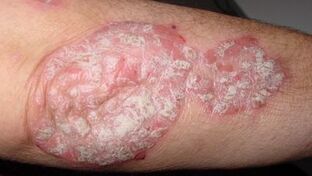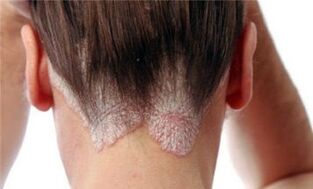
Psoriasis is a long-term chronic skin disease.
The causes of the disease
Psoriasis occurs due to the pathology of the skin cells, when the upper layer of the skin dies within 4-5 days, while usually this time interval is several weeks. The causes of the disease are not fully understood, but doctors have identified several factors that provoke the disease:
- Hereditary predisposition - the disease manifests itself at a young age, starting at 15 years, and is more often inherited. If one parent is diagnosed with psoriasis, the child has more than a 50% chance of getting sick.
- Autoimmune conflict - in this type of disorder, the body's immune cells stop recognizing skin cells as part of the body, starting to attack them as foreign elements.
- Nerve shocks - contribute to the release of hormones in the blood, which leads to metabolic disorders and provokes the development of the disease.
- Disorders of hormonal balance and metabolism.
Psoriasis is not contagious because there are no infectious agents that can be transmitted.
Symptoms of psoriasis
The main symptoms of the disease are characteristic skin rashes, affecting mainly the inner surface of the elbow and knee joints, as well as those areas of the skin that are subject to frequent friction injuries.
Rashes on the edge of the scalp and other less typical localizations may occur.
Skin rashes appear as patches covered with grayish or white scales. Skin rashes in psoriasis have three characteristics:
- Stearin stain symptom:The whitish scales peel off easily, resembling wax crumbs from candles.
- Terminal film- after removing the scales under them you can see a whitish film covering the surface of the stain.
- Spot bleeding- scratching the area removes the terminal film, damaging the skin papillae, on which small drops of blood protrude.
At an early stage a pale rim forms around the papule, at this stage no peeling occurs. Paleness around the spot is a vascular reaction of the body to the rejection of the epidermis. The disease is accompanied by severe itching of the skin; when scratching the skin, cracks and minor bleeding occur. A secondary infection may join to penetrate the damaged skin.
In addition to the skin, psoriasis affects the nails, causing brittleness of the nail plates, the appearance of a transverse pattern and concave areas.
Autoimmune conflict can affect the joints, causing arthritis-like pain, especially in the finger joints.
Types of psoriasis
Type 1 psoriasis occurs in people under the age of 30, it is an inherited disease that mainly affects the skin and has a typical localization.
Type II psoriasis affects people over forty and is not inherited. More often it affects the nail plates and scalp, the rash is small and teardrop-shaped. The disease in elderly patients is due to reduced immunity against the background of chronic infectious diseases and improper lifestyle.
Clinical studies have shown a link between type 2 psoriasis and alcohol and unhealthy food abuse.
Forms of psoriasis

Psoriasis has several forms with different severity:
- Plaque psoriasis- characteristic papules form on the skin, accompanied by itching and scaling.
- Pustular formis characterized by the appearance of blisters, redness of the skin around them, severe itching and burning, is considered a moderate form of the disease.
- Erythrodermais characterized by massive skin lesions accompanied by leakage and separation of large layers of the epidermis, especially difficult to tolerate, often accompanied by pustular lesions and fungal infection.
Stages of psoriasis
The disease develops in several stages:
- The initial stagesignals the beginning of the disease, during this period there are one, rarely several, pale spots, the skin begins to peel off.
- The active stageis accompanied by severe symptoms, profuse peeling, itching and inflammation.
- Stationary phase- shows remission, peeling at this stage practically stops, instead of a spot pigmentation or pale areas of pseudoatrophy are formed.
Diagnosis of psoriasis
To make a diagnosis, you need to visit a dermatologist. The pathology has a clear clinical picture, confirmed by the anamnesis and biopsy of skin elements with their subsequent examination.
Treatment of psoriasis
The treatment of the disease should be approached comprehensively, while at the same time stopping the external symptoms and influencing the possible cause of the disease.
Drug therapy
In severe cases of the disease, measures are taken to reduce the body's immune attack on its own cells:
- Cytostatics;
- Antihistamines;
- corticosteroid hormones;
- Enterosorbents and hepatoprotectors are used to restore metabolism.
At the same time, measures are taken to saturate the body with the necessary vitamins and trace elements:
- Silicon is one of the important trace elements responsible for hormonal balance and skin health.
- Calcium and vitamin D3 are needed to bring the disease into remission. It is prescribed together to increase calcium absorption.
Local Remedies

External agents in the form of ointments and creams are used to protect the skin:
- Glucocorticoids, which reduce the immune response, also reduce the symptoms of inflammation, relieve itching and swelling of the skin.
- Salicylic acid and plant products are essential for moisturizing the skin and protecting against secondary infections.
- Local cytostatics are used only in the active phase of the disease with its severe course.
Procedures
To speed up the healing process, physiological procedures are prescribed:
- Cryotherapy;
- UV radiation;
- Laser processing.
If necessary, plasmapheresis is performed to purify the blood plasma and stabilize the cells.
Prevention
If a predisposition to the disease is found, a number of preventive measures need to be taken:
- Lead a healthy lifestyle, quit smoking and alcohol;
- Build a daily routine, avoid stress, approach the organization of the work schedule rationally;
- Follow a diet, avoid excessive amounts of carbohydrates, spices and fatty foods. It is advisable to avoid preservatives and immediate foods;
- Spend enough time outdoors;
- Use soap and shampoo with a specially selected pH value, do not use hard towels and towels, dry the skin well after a shower;
- Wear clothes made of natural materials that are not too close to the body;
- Periodically undergo a medical examination, monitor the level of hormones in the blood and, if necessary, start early treatment.
Such measures will help maintain healthy skin and significantly improve the quality of life.























